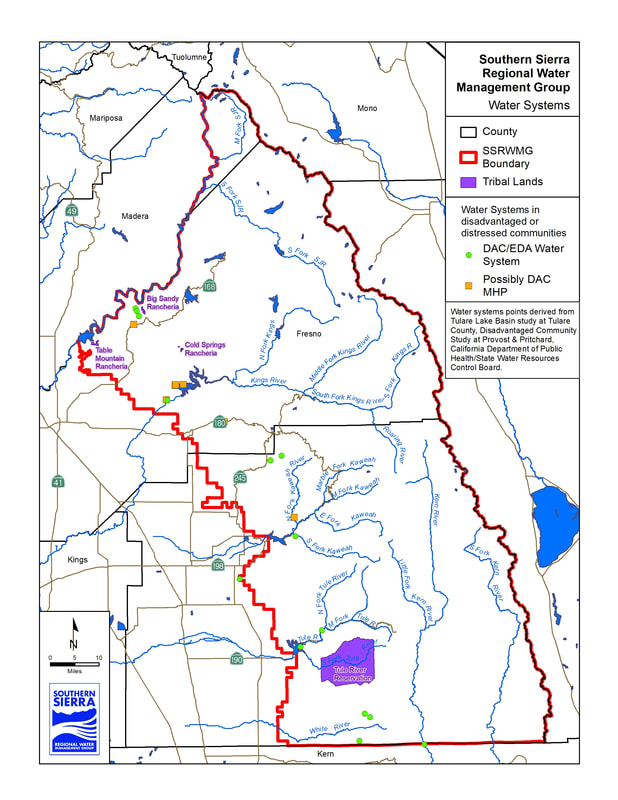Southern Sierra Regional Water Management
|
The Southern Sierra region of California is the fourth largest Integrated Regional Water Management (IRWM) region in the state, covering approximately 6,195 square miles. It includes many of California’s most precious natural resources: Sequoia and Kings National Parks, Sequoia and Sierra National Forests, and Devils Post Pile National Monument, and the upper watersheds of the San Joaquin, Kings, Kaweah, Tule, White and Kern Rivers, in addition to several smaller stream watersheds. The Southern Sierra IRWM (SSIRWM) boundary contains the foothill and Sierra Nevada portions of Madera, Fresno, and Tulare counties; lands representing several Native American Tribes; and jurisdictional areas for several federal land agencies.
The region’s headwaters supply clean water to California's San Joaquin Valley farms. Water, in fact, is the single largest export of the SSIRWM region. The region’s headwaters, which pass through several major rivers and storage facilities, irrigate hundreds of thousands of acres of farmland in the nation’s top-producing counties. The region provides essential water storage for the San Joaquin Valley. Most of the region’s precipitation occurs as snowfall that is stored in the Sierra Nevada until it melts and travels downstream to Valley farms and communities. An established network of more than twelve dams and reservoirs provides water storage, flood control, and energy for the Southern San Joaquin Valley. These dams provide annual storage of over 2,605,600 acre-feet of water and supply 2,973 megawatts of hydroelectric power. When released, the water is a critical component of the Valley’s scenic resources, water-dependent wildlife, more than half of the agricultural water supply, and groundwater recharge efforts. About 77% of the region (or 3,030,000 acres) is designated as federal lands: national parks, forests, and monuments. These public lands protect important resources like the Giant Sequoia groves, mountain meadows, geologic resources, and unique flora and fauna. The region provides other important ecosystem services (resources and processes supplied by natural ecosystems that benefit humans) like soil generation, water storage, water and air purification, and recreational and educational opportunities. The region is sparsely populated, though demographics are changing. Approximately 34,000 residents live within the SSIRWM boundaries, concentrated in several communities and tribal areas including Shaver Lake, Millerton/ Friant, Big Sandy Rancheria, Tule River Indian Rancheria, Springville and Three Rivers. There are also several resort areas and tourist destinations that create significant resource impacts. More than two million visitors per year are drawn to the area to visit Sequoia and Sierra National Forests, Sequoia and Kings Canyon National Parks, and Devils Post Pile National Monument. Tourism is critical to the economic welfare of the region, yet places a large burden on the region’s water supply resources and wastewater treatment capacities. Significant and increasing challenges—changing land uses, rapid climate change, habitat fragmentation, severe air pollution, altered fire regimes, invasive species, and more—are posing severe challenges to the landscape and the benefits that its natural processes provide. Meeting these challenges will require integrated and coordinated planning, commitment, and action among diverse stakeholders throughout the region— local, tribal, nonprofit, state and federal stakeholders—from the tallest Sierra peaks, along every riparian corridor, down to the Valley floor. |
THE ADOPTED SOUTHERN SIERRA INTEGRATED REGIONAL WATER MANAGEMENT PLAN IS AVAILABLE FOR DOWNLOAD:
| ||||||


